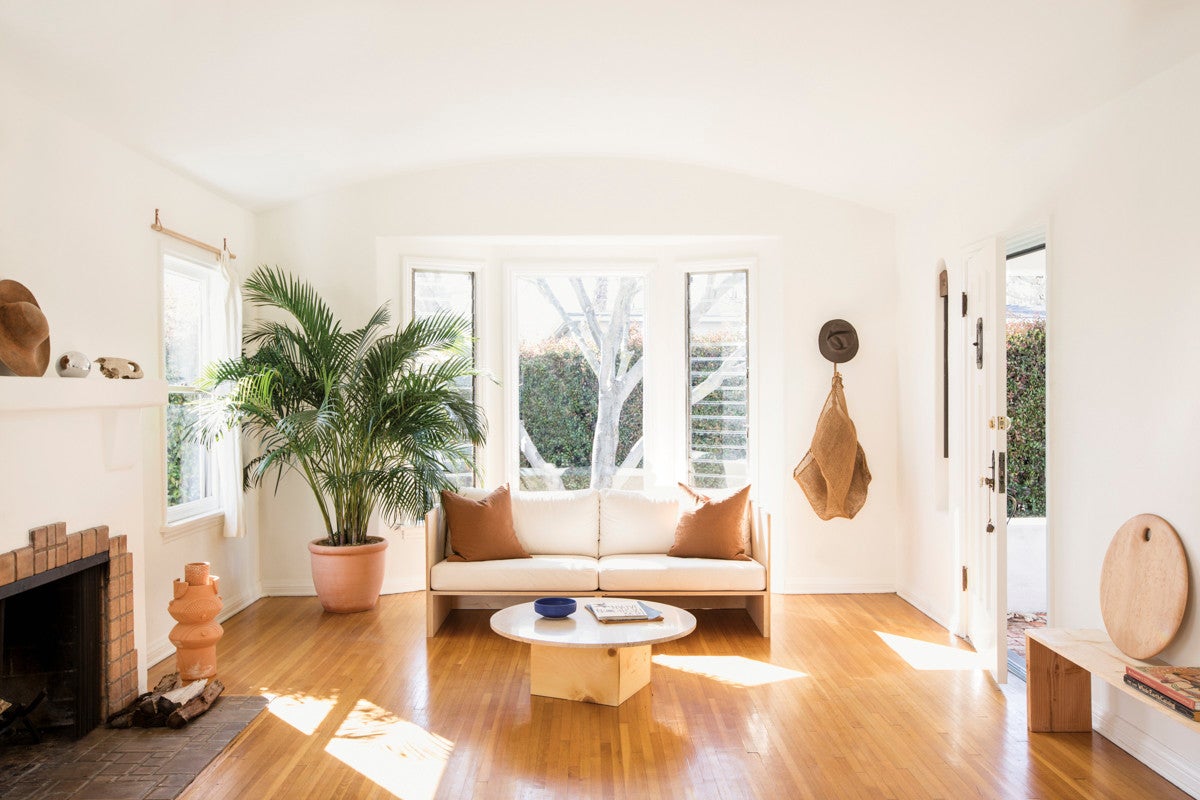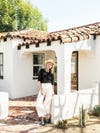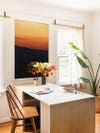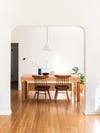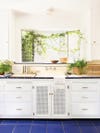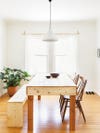Tour a Fashion Designer’s Less-Is-More LA Office
Jesse Kamm outfitted her new workspace with her own furniture designs and a pared back approach to decorating—here's how she did it.
Updated May 8, 2019 10:29 AM
We may earn revenue from the products available on this page and participate in affiliate programs.
If Jesse Kamm had her way, we’d all be living “a bit like it’s 1976.” The Los Angeles–based designer of the high-waisted, cropped Kamm pants—which have amassed a near cult following for their crisp cut and vintage vibes—would love to see us put down our phones, crack open an old-school how-to guide, and make something one of a kind.
Raised in the Midwest by parents who “would go to the library to learn a building project,” Kamm should know the rewards of being resourceful. In just over a decade, she has steadfastly carved out a business and life that align with her singular vision—one that balances hard work with creative breaks.
For two months every summer, Kamm, her husband, Luke, and 9-year-old son, Jules, head to Panama, where the family built a surf cabin from scratch. Taking time to truly unplug, recharge, and essentially live off the grid has become a top priority.
“We’re the best versions of ourselves there,” says Kamm. Rather than operate her clothing line at the nonstop pace of most online shops, she runs an ultra-lean team and offers a tight edit of seasonless styles.
The same approach is true of her latest project: setting up the first Jesse Kamm headquarters. Working out of her home in the Mount Washington neighborhood had kept overhead costs low, but Kamm finally caved when the company’s growing success was overflowing into her personal space.
Plus, the property she found was too good to pass up: a 1930s bungalow a four-minute drive away that her friend was selling, with all the original quirks and “cool little nooks” still intact—telephone alcove and milk delivery door included.
Using simple furniture designs she and Luke had developed for their Panama outpost (in part inspired by Donald Judd), they built pieces to best fit the office and showroom—a boxy sofa covered in leftover canvas, a coffee-table base with a repurposed marble top scored on Craigslist, and a low bench to display favorite finds.
Other than a few splurges on vintage items (Russel Wright dining chairs; an Arne Jacobsen pendant light), the couple left things mostly untouched. “I love that no one had the chance to flip the house and make it modern,” says Kamm, who shared with us her takeaways on the space.
Take your time
After moving into the bungalow-turned-office, Kamm saw it as a blank canvas. But she resisted the expectation to fill it up fast when clients started visiting. “I had this moment of thinking: Oh, it’s not special enough—but that’s the point. It should sit there quietly until the right thing comes along,” she explains.
To find those unique pieces, Kamm checks out garage sales, junk shops, Craigslist—and, of course, makes the odd design herself. She insists that anyone can learn to build a basic table with enough YouTube tutorials and how-to books. The idea is to get away from the one-click purchase that gives instant gratification but less satisfaction in the long run. “To be comfortable enough in your space (and skin) is to be patient,” she says.
Get scrappy
When Kamm was about to sell a daybed she had made to free up space for a drafting table, she realized the answer was right in front of her: Flip the piece on its side and secure it to the wall. “Laboring over the solution became a nice little meditation,” says Kamm, “then everything started to flow.”
Reimagining new uses for things and putting them together “unwinds the mind”—like the bulletin board she fashioned out of industrial cork flooring: “Whenever I’m designing my line, I can’t think directly about it; I have to have a hands-on side project. It’s the ultimate stress reliever.”
Be an original
Making things, having your own designs built, modifying secondhand items, or buying vintage isn’t just about getting creative. “The way that I appoint my spaces is all about being an individual,” says Kamm.
Rather than replicate an entire look, think about what elements in particular inspire you—and how you can make them yours. “Build the thing that works perfectly in your space, rather than copy/pasting from someone else’s home,” suggests Kamm.
Experimentation is also key. “I’ll nail four holes in the wall until I find the right spot. It can be a little wabi-sabi,” she says. “You don’t need to strive for perfection!”
Know your resources
“Building furniture—or even a home—isn’t that different from a coat,” Kamm says. “There’s a pattern or layout, materials, and how it all fits together, which can be fancy or simple.” The plywood and pine pieces the designer made for her office came to a grand total of $850 in supplies, and she evolved her original designs to include counter-sinking screws and wood plugs to conceal the hardware.
Kamm recommends checking out your local lumberyard and other material suppliers for the best classroom around; they can counsel you on what to buy and (once you’re friends) might strike you a great deal. Next on her to-do list: making doors. “I’m constantly open to learning about how things are made,” says Kamm. “It’s the builder in me.”
This story originally appeared in the Summer 2018 issue with the headline “The Natural.”
See more inspiring spaces:
A Neutral Denver Home Full of Texture and Cool Antiques
We Would Like to Live in This Photographer’s Breezy Living Room
Inside a Yogi’s Tranquil, 500-Square-Foot NYC Home
